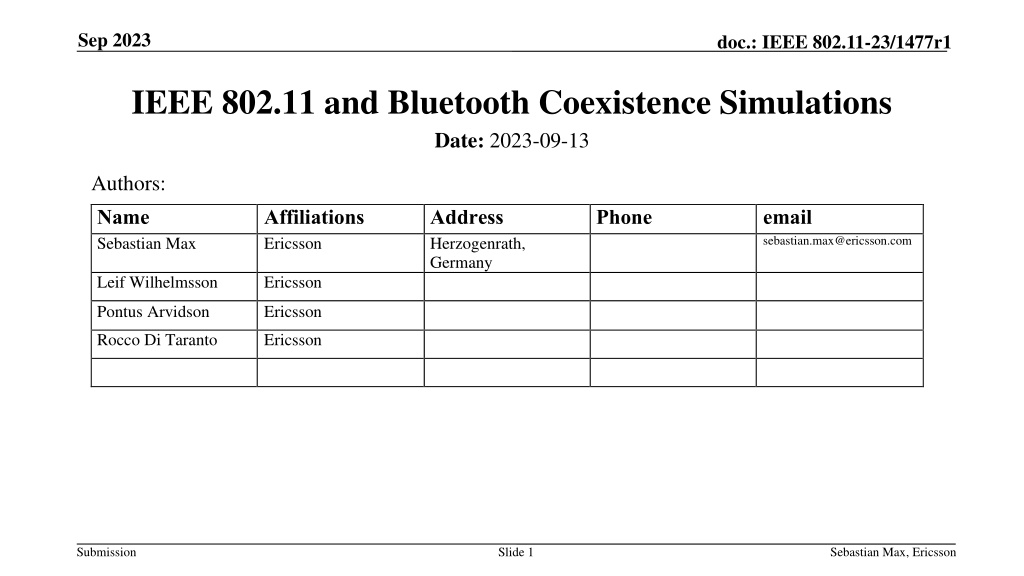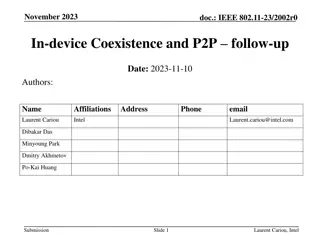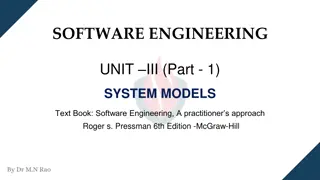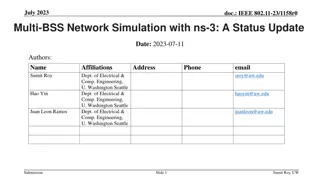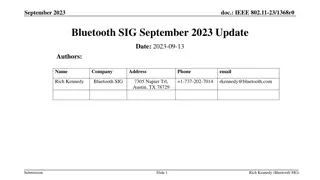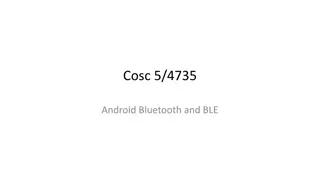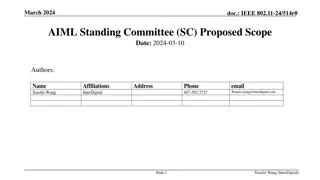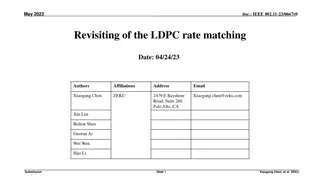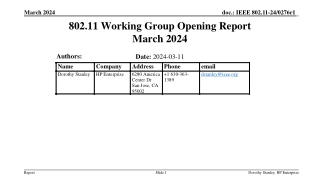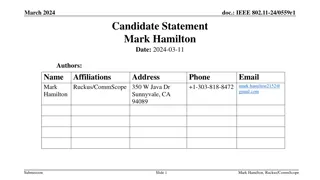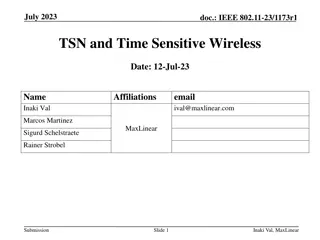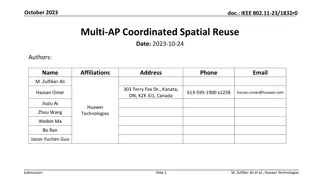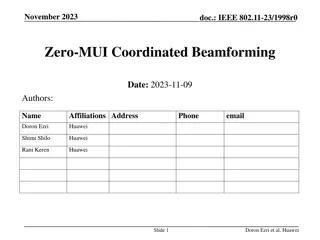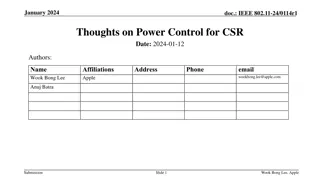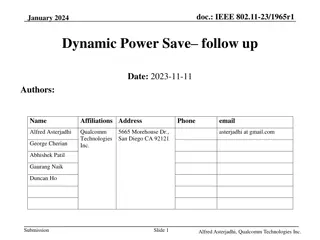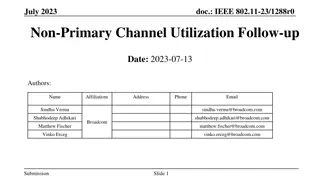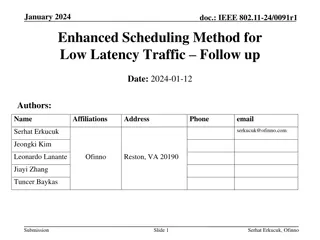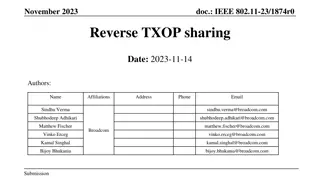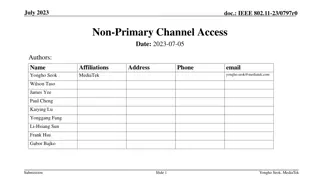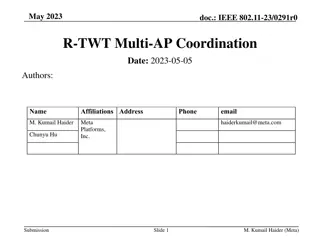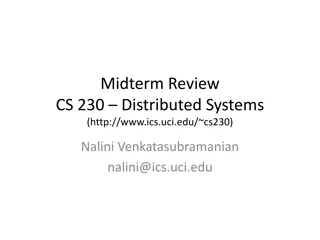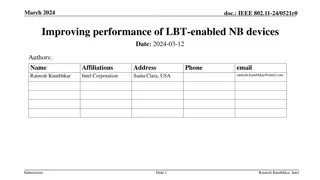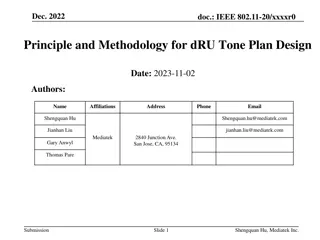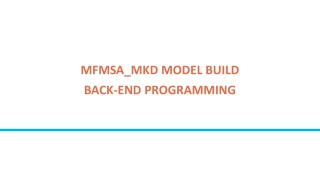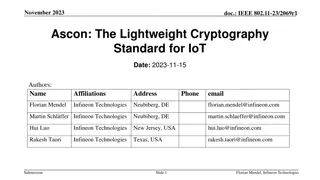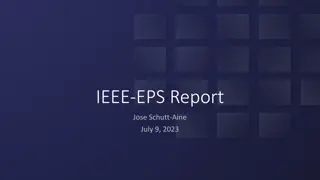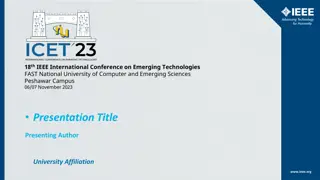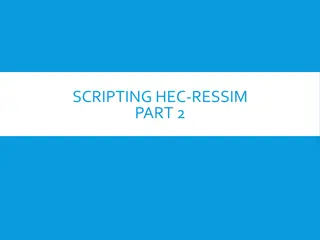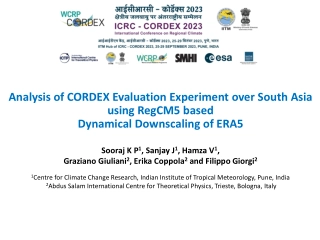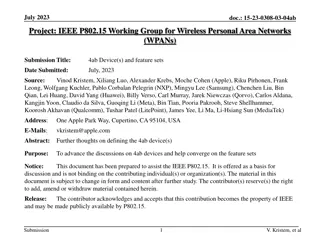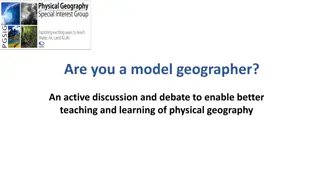IEEE 802.11 and Bluetooth Coexistence Simulations: Assumptions and Models
This document presents simulations on the coexistence of IEEE 802.11 (Wi-Fi) and Bluetooth technologies in the 5.945GHz to 6.425GHz spectrum. It explores various assumptions and models, including spectrum usage, channelization, scenario setups for Bluetooth and Wi-Fi links, and the capabilities of both technologies in terms of channel allocation, transmit power, noise figures, and detection thresholds. The impact of changing these assumptions on the simulation results is discussed, highlighting the realistic considerations that need to be made for effective coexistence.
IEEE 802.11 and Bluetooth Coexistence Simulations: Assumptions and Models
PowerPoint presentation about 'IEEE 802.11 and Bluetooth Coexistence Simulations: Assumptions and Models'. This presentation describes the topic on This document presents simulations on the coexistence of IEEE 802.11 (Wi-Fi) and Bluetooth technologies in the 5.945GHz to 6.425GHz spectrum. It explores various assumptions and models, including spectrum usage, channelization, scenario setups for Bluetooth and Wi-Fi links, and the capabilities of both technologies in terms of channel allocation, transmit power, noise figures, and detection thresholds. The impact of changing these assumptions on the simulation results is discussed, highlighting the realistic considerations that need to be made for effective coexistence.. Download this presentation absolutely free.
Presentation Transcript
Sep 2023 doc.: IEEE 802.11-23/1477r1 IEEE 802.11 and Bluetooth Coexistence Simulations Date: 2023-09-13 Authors: Name Sebastian Max Affiliations Ericsson Address Herzogenrath, Germany Phone email sebastian.max@ericsson.com Leif Wilhelmsson Ericsson Pontus Arvidson Ericsson Rocco Di Taranto Ericsson Submission Slide 1 Sebastian Max, Ericsson
Sep 2023 doc.: IEEE 802.11-23/1477r1 Introduction Multiple contributions on coexistence of Contributions are based on simulations What are the underlying assumptions / models? What is the impact of changing the assumptions on the results? Which assumptions are realistic / need to be considered? Listen-Before-Talk (LBT) based wideband ( Wi-Fi ) with Narrow-Band Frequency Hopping (NBFH) ( Bluetooth or BLE ) in the same spectrum (5.945 GHz to 6.425 GHz) IEEE 802.11-23/0453: eDAA claimed to be inadequate LBT (for NBFH) appears to work quite well IEEE 802.11-23/0877: NBFH with eDAA can co-exist with Wi-Fi without LBT Submission Slide 2 Sebastian Max, Ericsson
Sep 2023 doc.: IEEE 802.11-23/1477r1 Assumption 1: Spectrum Usage / Channelization 480MHz 0 79 159 Bluetooth 5.945 6.425 GHz 15 (160 MHz) 47 (160 MHz) 79 (160 MHz) 1 33 65 Wi-Fi Bluetooth 1 MHz channels with 0.5MHz guard band left & right Maximum 480MHz 2MHz = 240 channels 3 advertising channels (0, 79, 159) 233 data channels (highest prime number below 237) Center frequency of channel 0 at 5.947MHz Each connection selects its frequency hopping size randomly between 44 and 94 Scaled up from 2.4GHz operation (37 channels, hopping size 7 to 15) Wi-Fi 3 160MHz channels (channel number 15, 47, 79) Primary-20 always the first 20MHz Submission Slide 3 Sebastian Max, Ericsson
Sep 2023 doc.: IEEE 802.11-23/1477r1 Assumption 2: Scenario Six Bluetooth links Constant bitrate traffic 320B/20ms ( 128kb/s) 640B/20ms ( 256kb/s) 1280/20ms ( 512kb/s) KPI: Packet delay 1, 2, or 3 Wi-Fi links Infinite number of 10 MB file downloads via FTP ~3 s start delay KPI: File download delay Channel model AWGN with Line-of-Sight for d < 5 m (pathloss coefficient 2.0), Non-Line-of-Sight for d > 5 m (3.5) Submission Slide 4 Sebastian Max, Ericsson
Sep 2023 doc.: IEEE 802.11-23/1477r1 Assumption 3: Capabilities Wi-Fi 1 , 2 , or 3 non-overlapping 160MHz channels 23dBm transmit power Receiver Noise Figure 6dB LBT: Energy detection threshold 71dBm/20MHz according to EN 303 687 Optional: Puncturing of 20 MHz channels Bluetooth 233 data channels + 3 advertising channels 10dBm transmit power Receiver Noise Figure 8dB 10ms connection interval between connection events 1 Mb/s PHY Optional: enhanced Detect-And-Avoid (eDAA) Optional: LBT before connection event Submission Slide 5 Sebastian Max, Ericsson
Sep 2023 doc.: IEEE 802.11-23/1477r1 Scenario Impact: Bluetooth Load 320B payload every 20ms: Two segments fit into one connection event Every other connection event remains idle ~16 % channel usage 1280B payload every 20ms: Five segments, require two connection events ~57 % channel usage Saturation at ~1600B/20ms Idle time required to handle retransmissions Build-up of transmit queues, unusable delay values 320B 320B Seg 1 Seg 2 2.088ms 0.888ms Seg 1 Seg 2 t [ms] 10 20 0 Submission Slide 6 Sebastian Max, Ericsson
Sep 2023 doc.: IEEE 802.11-23/1477r1 Scenario Impact: Channel Conditions Static & deterministic channel model Received power only depends on frequency and distance Allows calculation of possible channel conditions Without interference: Wi-Fi has perfect conditions Bluetooth has perfect conditions -38dBm (1MHz) 68dB Submission Slide 7 Sebastian Max, Ericsson
Sep 2023 doc.: IEEE 802.11-23/1477r1 Scenario Impact: Channel Conditions Wi-Fi interfered by Bluetooth Bluetooth interfered by Wi-Fi 33dB / 15dB Interference triggers ED at STA & AP Very strong interference at STA -49.5dBm received signal power vs. -44dBm received interference power SINR = 27 dB (on 1 MHz) Impact depends on Packet error model Slightly interfered Interference is spread over 160 MHz Large distance to AP Interfered by AP: SINR = 33dB Interfered by STA: SINR = 15dB Essentially no impact -44dBm -53dBm -71dBm -27dB (1MHz) Wi-Fi link Wi-Fi link -62dBm -9dB (1MHz) Submission Slide 8 Sebastian Max, Ericsson
Sep 2023 doc.: IEEE 802.11-23/1477r1 Assumption 4.1: Wi-Fi Packet Error Model average MI = 159 160 MI(36dB) + 1 160 MI(-27dB) = 159 160 10b + 1 160 0b = 9.93b OK (strong narrow-band interference is averaged out) (-27dB) Power Spectral Density -44.3 PER Model A (average Mutual Information, according to 11ax evaluation methodology PHY abstraction optimistic ) -71.5 [dBm/MHz] MI(C/I) (36dB) (36dB) = MI( -71dBm/MHz 160MHz -44dBm/MHz 1MHz ) PER Model B (Mutual Information of C/I pessimistic ) -108 = MI (-49dBm -44dBm) 5.945 6.105 GHz f = MI(-5dB) = 0b Failed (strong narrow-band interference dominates the packet error probability) Submission Slide 9 Sebastian Max, Ericsson
Sep 2023 doc.: IEEE 802.11-23/1477r1 Assumption 4.2: Bluetooth Packet Error Model For every reception Calculate SINR for every bit Map SINR to bit error rate Random number draw per bit Decision on success/failed reception Submission Slide 10 Sebastian Max, Ericsson
Sep 2023 doc.: IEEE 802.11-23/1477r1 Coexistence mechanisms Submission Slide 11 Sebastian Max, Ericsson
Sep 2023 doc.: IEEE 802.11-23/1477r1 Bluetooth: LBT before Connection Event (CE-LBT) Sense current channel before every connection event Idle: transmit Busy: defer until next connection event Submission Slide 12 Sebastian Max, Ericsson
Sep 2023 doc.: IEEE 802.11-23/1477r1 Bluetooth: eDAA combined with CE-LBT CE-LBT detects channel as busy Defer transmission to the next connection event Block channel and all channels belonging to the corresponding 20MHz block from future use Special case: if channel is centered between two 20MHz blocks, then block all channels belonging to the right and left block Same procedure for two consecutive CRC failures within a connection event At least 15 unblocked channels remain 47 channels / 94MHz 47 channels / 94MHz 0 79 5.945 Submission Slide 13 Sebastian Max, Ericsson
Sep 2023 doc.: IEEE 802.11-23/1477r1 Wi-Fi: Puncturing LBT without Puncturing f LBT with Puncturing f 160 160 Tx ED ED Tx ED ED Tx AIFS AIFS AIFS primary primary AIFS t t Backoff Backoff Backoff Backoff AIFS / Backoff countdown starts on primary 20MHz only Energy Detection (ED) on all channels begins 25 s before each transmission Only transmit if all sub-channels are idle Puncturing allows 20MHz holes in the spectrum Primary 20MHz must be idle Assumption: puncturing is fully dynamic and flexible concerning which 20MHz is punctured Submission Slide 14 Sebastian Max, Ericsson
Sep 2023 doc.: IEEE 802.11-23/1477r1 Results Submission Slide 15 Sebastian Max, Ericsson
Sep 2023 doc.: IEEE 802.11-23/1477r1 No Interference Wi-Fi Bluetooth Packet delay depends on size and if fragments fit into one connection event Small chance of collisions of the six links FTP download delay slightly higher than 100ms Submission Slide 16 Sebastian Max, Ericsson
Sep 2023 doc.: IEEE 802.11-23/1477r1 Baseline: No Coexistence Mechanisms Optimistic PER Model 320B / 20ms load Wi-Fi High impact of Bluetooth interference Depending on Bluetooth load Optimistic PER model: impact only due to LBT Pessimistic PER model: impact due to LBT (interference first) and packet errors (interference second) Approx. factor 2 delay for 320B/20ms, unusable for 1280B/20ms Pessimistic PER Model 1280B / 20ms load Bluetooth No impact of Wi-Fi interference on packet delay Submission Slide 17 Sebastian Max, Ericsson
Sep 2023 doc.: IEEE 802.11-23/1477r1 Coexistence 1: Bluetooth with CE-LBT (but no eDAA) Wi-Fi (only for 1280B Bluetooth packets) Significant improvement vs. Bluetooth without LBT Optimistic PER Model 320B / 20ms load Bluetooth Introduction of delay steps due to missed Connection Events (CEs) Reduction of capacity leads to oversaturation case for many BSSs or large packet size Pessimistic PER Model 1280B / 20ms load Submission Slide 18 Sebastian Max, Ericsson
Sep 2023 doc.: IEEE 802.11-23/1477r1 Coexistence 2: Bluetooth with CE-LBT and eDAA Wi-Fi (only for 1280 B Bluetooth packets) Bluetooth has essentially no impact on Wi-Fi Optimistic PER Model 320B / 20ms load Bluetooth One or two BSS, i.e., at least 160 MHz idle: Good coexistence Three BSS: Links fail to find idle channels, oversaturation case even for 320B per 20ms Pessimistic PER Model 1280B / 20ms load Submission Slide 19 Sebastian Max, Ericsson
Sep 2023 doc.: IEEE 802.11-23/1477r1 Coexistence 3: Wi-Fi with Puncturing Wi-Fi (only for 1280 B Bluetooth packets) Significant improvement over no coex mechanism Channel access delay is reduced to interference-free case, only packet errors remain Optimistic PER Model 320B / 20ms load Pessimistic PER Model 1280B / 20ms load Bluetooth Same results as in no interference case Submission Slide 20 Sebastian Max, Ericsson
Sep 2023 doc.: IEEE 802.11-23/1477r1 Coexistence 4: Wi-Fi with Puncturing, Bluetooth with CE-LBT & eDAA Optimistic PER Model 320B / 20ms load Wi-Fi (only for 1280B Bluetooth packets) Significant improvement over no coex mechanism Channel access delay is reduced to interference-free case, only packet errors remain Pessimistic PER Model 1280B / 20ms load Bluetooth Same results as if Wi-Fi does not puncture Submission Slide 21 Sebastian Max, Ericsson
Sep 2023 doc.: IEEE 802.11-23/1477r1 Conclusions Wi-Fi interfered by Bluetooth Increased channel access delay due to LBT Counteracted by puncturing May increase packet errors due to strong, narrow-band interference Is it possible to enhance resilience if only 1MHz of 160MHz is interfered? Bluetooth interfered by Wi-Fi Robust against wideband interference (in this scenario) Introduction of CE-LBT (together with eDAA) (i) may increase delays and (ii) may suppress connections, depending on Wi-Fi channel usage Submission Slide 22 Sebastian Max, Ericsson
Sep 2023 doc.: IEEE 802.11-23/1477r1 Assumption 2B: Scenario B Decrease Bluetooth transmit power to 0dBm Less signal strength at headsets Increase Bluetooth device distance to 2m More pathloss Move Bluetooth links to the center between the Wi-Fi links More interference by the downlink-heavy Wi-Fi traffic 10 Bluetooth links Bluetooth links Wi-Fi link Wi-Fi link Wi-Fi link y [m] 5 0 8 -8 0 x [m] Submission Slide 23 Sebastian Max, Ericsson
Sep 2023 doc.: IEEE 802.11-23/1477r1 Scenario B Impact: Channel Conditions Wi-Fi interfered by Bluetooth Bluetooth interfered by Wi-Fi Interference still triggers ED at STA & AP Less (but still significant) interference at STA C/I = 11dB SNR = 11dB (on 1MHz) Strong interference SNR from 52dB down to 6dB if AP is transmitting Submission Slide 24 Sebastian Max, Ericsson
Sep 2023 doc.: IEEE 802.11-23/1477r1 Scenario B Impact: Baseline / No Coexistence Mechanisms Scenario A Scenario B Increased packet delay for Bluetooth due to packet errors and retransmissions in the next connection event Slightly higher delay for Wi-Fi due to increased Bluetooth interference Submission Slide 25 Sebastian Max, Ericsson
Sep 2023 doc.: IEEE 802.11-23/1477r1 Scenario B Impact: Wi-Fi with Puncturing Scenario A Scenario B Increased packet delay for Bluetooth due to higher interference power in non- punctured channels Wi-Fi delay slightly better than in Scenario A less interference power from Bluetooth due to larger distance Submission Slide 26 Sebastian Max, Ericsson
Sep 2023 doc.: IEEE 802.11-23/1477r1 Scenario B Impact: Wi-Fi with puncturing, Bluetooth with CE-LBT & eDAA Scenario A Scenario B Bluetooth results are slightly worse than in Scenario A Wi-Fi completely recovers, similar as in Scenario A Submission Slide 27 Sebastian Max, Ericsson
Sep 2023 doc.: IEEE 802.11-23/1477r1 Conclusions (ii) Wi-Fi interfered by Bluetooth Increased channel access delay due to LBT Counteracted by puncturing May increase packet errors due to strong, narrow-band interference Is it possible to enhance resilience if only 1MHz of 160MHz is interfered? Bluetooth interfered by Wi-Fi Introduction of CE-LBT (together with eDAA) (i) reduces packet error rate caused by interference, (ii) may increase delays and (iii) may suppress connections, depending on Wi-Fi channel usage 1. 2. 3. Bluetooth requires some form of CE-LBT to reduce interference impact The assumed approach is too sensitive Bluetooth may be completely suppressed by Wi-Fi Wi-Fi with puncturing eliminates the LBT access delay resulting from narrow-band interference Submission Slide 28 Sebastian Max, Ericsson
Sep 2023 doc.: IEEE 802.11-23/1477r1 Appendix: All Simulation Results Submission Slide 29 Sebastian Max, Ericsson
doc.: IEEE 802.11-23/1477r1 BASELINE: NO COEX MECHANISMS Submission
doc.: IEEE 802.11-23/1477r1 Scenario A, optimistic PER model Submission
doc.: IEEE 802.11-23/1477r1 Scenario A, pessimistic PER model Submission
doc.: IEEE 802.11-23/1477r1 Scenario B, optimistic PER model Submission
doc.: IEEE 802.11-23/1477r1 Scenario B, pessimistic PER model Submission
doc.: IEEE 802.11-23/1477r1 COEX: BLE WITH LBT Submission
doc.: IEEE 802.11-23/1477r1 Scenario A, optimistic PER model Submission
doc.: IEEE 802.11-23/1477r1 Scenario A, pessimistic PER model Submission
doc.: IEEE 802.11-23/1477r1 Scenario B, optimistic PER model Submission
doc.: IEEE 802.11-23/1477r1 Scenario B, pessimistic PER model Submission
doc.: IEEE 802.11-23/1477r1 COEX: BLE WITH LBT & EDAA Submission
doc.: IEEE 802.11-23/1477r1 Scenario A, optimistic PER model Submission
doc.: IEEE 802.11-23/1477r1 Scenario A, pessimistic PER model Submission
doc.: IEEE 802.11-23/1477r1 Scenario B, optimistic PER model Submission
doc.: IEEE 802.11-23/1477r1 Scenario B, pessimistic PER model Submission
doc.: IEEE 802.11-23/1477r1 COEX: WI-FI DYNAMICALLY PUNCTURES OCCUPIED 20 MHZ Submission
doc.: IEEE 802.11-23/1477r1 Scenario A, optimistic PER model Submission
doc.: IEEE 802.11-23/1477r1 Scenario A, pessimistic PER model Submission
doc.: IEEE 802.11-23/1477r1 Scenario B, optimistic PER model Submission
doc.: IEEE 802.11-23/1477r1 Scenario B, pessimistic PER model Submission
doc.: IEEE 802.11-23/1477r1 COEX: WI-FI DYNAMICALLY PUNCTURES OCCUPIED 20 MHZ, BLE WITH LBT & EDAA Submission
